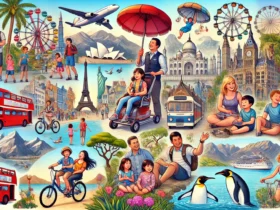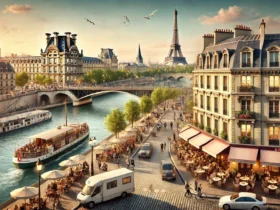Mexico is a country rich in history, culture, and natural beauty. From ancient ruins and colonial architecture to stunning beaches and vibrant cities, there’s something for everyone. Here are some of the best cities to visit in Mexico.
1. Mexico City
Key Attractions:
- Zócalo: The main square, surrounded by historic buildings.
- Chapultepec Park: One of the largest city parks in the world, home to museums, a zoo, and a castle.
- Frida Kahlo Museum: Dedicated to the life and work of the famous artist.
- Teotihuacan: Ancient Mesoamerican city known for its pyramids, located just outside the city.
- Palacio de Bellas Artes: An iconic cultural center.
Why Visit:
Mexico City, the capital, is a vibrant metropolis with a mix of modernity and tradition. It offers world-class museums, bustling markets, historic sites, and a thriving culinary scene.
2. Cancún
Key Attractions:
- Beaches: Known for their white sand and turquoise waters.
- Chichen Itza: One of the New Seven Wonders of the World, a short drive away.
- Isla Mujeres: A beautiful island perfect for day trips.
- Underwater Museum (MUSA): An underwater sculpture museum.
- Cenotes: Natural sinkholes perfect for swimming and diving.
Why Visit:
Cancún is famous for its stunning beaches, luxury resorts, and vibrant nightlife. It’s a gateway to the Mayan Riviera, offering access to historical sites and natural wonders.
3. Guadalajara
Key Attractions:
- Teatro Degollado: A historic theater known for its performances and architecture.
- Hospicio Cabañas: A UNESCO World Heritage site.
- Mariachi Music: Experience live performances in the city where mariachi music originated.
- Tequila Tours: Visit nearby tequila distilleries in the town of Tequila.
- Plaza de Armas: The main square with beautiful gardens and historic buildings.
Why Visit:
Guadalajara, Mexico’s second-largest city, is known for its rich cultural heritage, tequila, and mariachi music. The city’s historic center and vibrant arts scene make it a must-visit.
4. Oaxaca City
Key Attractions:
- Monte Albán: Ancient Zapotec city with impressive ruins.
- Zócalo: The bustling main square.
- Santo Domingo Church and Museum: A stunning baroque church with an attached museum.
- Markets: Famous for their local crafts and traditional foods.
- Guelaguetza Festival: An annual indigenous cultural event.
Why Visit:
Oaxaca City is known for its colonial architecture, indigenous culture, and exceptional cuisine. The city’s colorful festivals, bustling markets, and nearby archaeological sites offer a rich cultural experience.
5. Playa del Carmen
Key Attractions:
- Fifth Avenue (Quinta Avenida): A lively pedestrian street with shops, restaurants, and nightlife.
- Beaches: Known for their beauty and water activities.
- Xcaret Park: An eco-archaeological park offering various attractions.
- Cozumel: A nearby island known for diving and snorkeling.
- Cenotes: Numerous cenotes in the area for swimming and exploring.
Why Visit:
Playa del Carmen is a charming coastal city on the Riviera Maya. It offers beautiful beaches, vibrant nightlife, and easy access to nearby attractions like Cozumel and Xcaret Park.
6. Mérida
Key Attractions:
- Plaza Grande: The central square surrounded by historic buildings.
- Paseo de Montejo: A grand avenue with colonial mansions.
- Cenotes: Numerous cenotes nearby for swimming and exploring.
- Uxmal: An impressive Mayan archaeological site.
- Mayan World Museum: Showcasing the history and culture of the Mayan civilization.
Why Visit:
Mérida, the capital of Yucatán, is known for its colonial architecture, vibrant cultural scene, and proximity to Mayan ruins. The city’s relaxed atmosphere and rich history make it a great destination.
7. San Miguel de Allende
Key Attractions:
- Parroquia de San Miguel Arcángel: A stunning neo-Gothic church.
- El Jardín: The central plaza and social hub.
- Art Galleries and Studios: Known for its thriving arts community.
- Hot Springs: Nearby natural hot springs for relaxation.
- Fabrica La Aurora: An art and design center in a former textile factory.
Why Visit:
San Miguel de Allende is renowned for its well-preserved colonial architecture, vibrant arts scene, and charming cobblestone streets. The city’s cultural festivals and historic charm attract visitors from around the world.
Conclusion
Mexico offers a diverse range of cities, each with its unique attractions and cultural experiences. Whether you’re interested in history, culture, beaches, or nightlife, there’s a city in Mexico that will captivate you. Explore these top cities to experience the rich heritage and vibrant life of this beautiful country.
FAQs about Best Cities to Visit in Mexico
1. What is the best time to visit Mexico City?
- Answer: The best time to visit Mexico City is during the dry season, from November to April, when the weather is mild and there is less chance of rain.
2. Is Cancún safe for tourists?
- Answer: Yes, Cancún is generally safe for tourists, especially in the hotel zone and tourist areas. However, like any major tourist destination, it’s important to stay aware of your surroundings and take common safety precautions.
3. What is Guadalajara known for?
- Answer: Guadalajara is known for its rich cultural heritage, including mariachi music, tequila, and traditional Mexican cuisine. It’s also famous for its historic architecture and vibrant arts scene.
4. What are cenotes, and where can I find them?
- Answer: Cenotes are natural sinkholes filled with freshwater, often found in the Yucatán Peninsula. They are popular for swimming, snorkeling, and diving. Some of the best cenotes can be found near Cancún, Playa del Carmen, and Mérida.
5. How do I get to Teotihuacan from Mexico City?
- Answer: Teotihuacan is about 50 kilometers (31 miles) northeast of Mexico City. You can reach it by bus from the Autobuses del Norte station, by guided tour, or by driving.
6. What is the main language spoken in Mexico?
- Answer: The main language spoken in Mexico is Spanish. However, in tourist areas, many people also speak English.
7. Are there any annual festivals in Oaxaca City?
- Answer: Yes, Oaxaca City is known for its vibrant festivals, including the Guelaguetza Festival in July, which celebrates indigenous cultures with music, dance, and traditional costumes.
8. What currency is used in Mexico, and can I use US dollars?
- Answer: The official currency in Mexico is the Mexican Peso (MXN). While US dollars are accepted in some tourist areas and major hotels, it’s best to use pesos for most transactions.
9. What is the best way to travel around Playa del Carmen?
- Answer: Playa del Carmen is compact and walkable, but you can also use taxis, rental bikes, and colectivos (shared vans) for traveling around the city and to nearby attractions.
10. What is Mérida famous for?
- Answer: Mérida is famous for its colonial architecture, vibrant cultural scene, and proximity to Mayan ruins like Uxmal. It’s also known for its lively markets and traditional Yucatecan cuisine.
11. Are there direct flights to San Miguel de Allende?
- Answer: There are no direct flights to San Miguel de Allende. The nearest airports are in León (Bajío International Airport) and Querétaro, both about 1.5-2 hours away by car.
12. What should I pack for a trip to Cancún?
- Answer: Pack lightweight clothing, swimwear, sunscreen, a hat, sunglasses, and comfortable shoes. If you plan to visit cenotes or archaeological sites, bring water shoes and insect repellent.
13. Is it necessary to learn Spanish to visit Mexico?
- Answer: While it is not necessary to learn Spanish to visit Mexico, knowing some basic phrases can enhance your experience and help with communication, especially in areas less frequented by tourists.
14. What are some must-try foods in Guadalajara?
- Answer: In Guadalajara, try traditional dishes like birria (spicy stew), tortas ahogadas (drowned sandwiches), and pozole (hominy soup). Don’t forget to taste tequila, which originates from the nearby town of Tequila.
15. Can I use public transportation in Mexico City?
- Answer: Yes, Mexico City has an extensive public transportation system, including buses, a metro, and trolleybuses. The metro is an affordable and efficient way to get around the city.






Leave a Reply